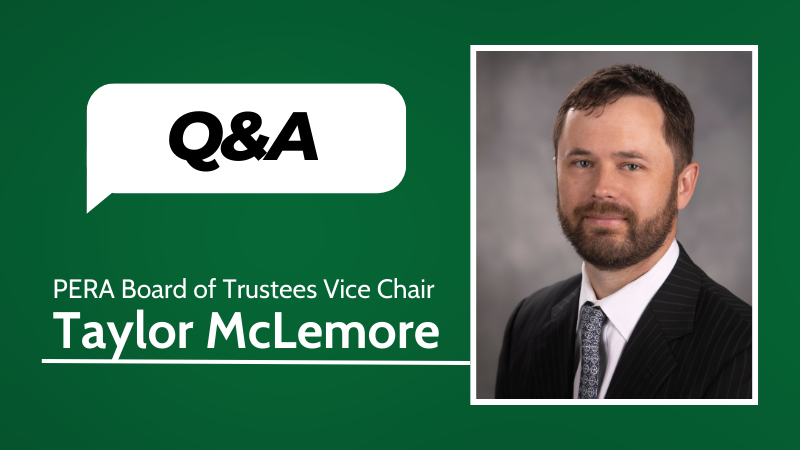On Tuesday, July 9,
Colorado PERA conducted telephone town halls for members and retirees. These
town halls gave members and retirees a chance to ask questions and talk to PERA
leadership about the investment performance in 2018, PERA’s funded status, and
the impact of recent legislation. If you missed the calls, recordings are
posted here.
A summary of the most asked questions and responses is below. Questions about
individual retirement benefits may be answered by contacting PERA Customer
Service at 1-800-759-7372.
What was PERA’s investment return in 2018? My investments did better in 2018.
For the year ending December 31, 2018, PERA’s investment portfolio returned a negative 3.5 percent. While last year’s return was disappointing, PERA is a long-term investor and the investment program is designed to perform over the long term. PERA’s investment program has returned 8.8 percent over 10 years.
For most investors, 2018 was a
difficult year. Global equities, as measured by the MSCI ACWI, declined 9.4
percent in 2018, while the Bloomberg Barclays U.S. Aggregate Bond index was
flat for the year. When comparing investment performance, it’s important to
keep the time period in mind. Different time frames will lead to differences in
investment performance because the market can fluctuate from one period to the
next.
What is PERA’s funded status after 2018?
Why did the funded status decline?
The funded status
for the PERA defined benefit trusts at the end of 2018 was 59.8 percent,
compared to 61.3 percent at the end of 2017.The investment return is just one piece of what goes into the
plan’s funded status. We also make assumptions about factors such as salaries,
head count growth, the number of retirements, among others. Last year, many of
our demographic assumptions didn’t play out favorably. For instance, payroll
growth was stronger than we expected, and the School Division, PERA’s largest,
had more early retirements. These factors also impact the funded status.
How is last year’s legislation working?
In 2018, the Colorado General Assembly passed Senate Bill 200 which included provisions to help PERA adapt to changes in demographics or the market. The legislation is designed to help ensure the fund’s stability over time and put PERA on a path to full funding by 2047. The bill made changes to the plan that included increases in contributions and modifications to benefits.
On July 1, active members, except
those who work in the Local Government Division, saw an increase in
contributions, and most members are now contributing 8.75 percent of their pay
toward their PERA benefit. PERA retirees are experiencing the second year of
the suspension of the annual increase (AI).
The legislation also included a
provision, called the automatic adjustment that is triggered when PERA falls
ahead of or behind schedule to reach full funding. These changes are not easy
on PERA members or retirees. They are, however, designed to make sure PERA
stays on the path that ensures retirement security today and tomorrow.
When will retirees get an annual increase?
Legislation in 2018 (SB 200)
suspended the annual increase for 2018 and 2019. The legislation also contained
“guard rails” (called the automatic adjustment) to keep PERA on the path to
full funding by 2047. The negative investment year in 2018 and other demographic
shifts affected PERA’s funded status, and the automatic adjustment will go into
effect in July 2020. This means that when the annual increase is restored in
July 2020, it will be 1.25 percent.
How does the automatic adjustment work, and how long will it take for
the AI to go back up and contributions to go down?
Last year’s investment losses
coupled with demographic shifts mean that PERA has fallen behind on its funding
goal, which has triggered the automatic adjustment. That means that the three
rates: member contributions, employer contributions, and the AI paid to
retirees, will all change beginning July 1, 2020.In July 2020, the AI paid to retirees will be set at a maximum of
1.25 percent.
SB 200 contained scheduled
increases for members (except for members in the Local Government Division) of
0.75 percent in July 2019, 0.75 percent in July 2020, and 0.5 percent in 2021. Due
to the automatic adjustment, member contributions will increase by an
additional 0.5 percent, on top of the scheduled increases, in July 2020. That
means in 2020, most members will contribute a total of 10 percent to PERA from
each paycheck.
The amount all employers contribute
to PERA will also increase by one half of one percent in July 2020. Total
employer contributions will range from 14.2 percent to 23.6 percent, depending
on the Division.
While it’s challenging to predict
exactly when the AI will go up and member and employer contribution rates will
go down, it may take a decade for these changes to go back to current levels.
Are PERA employees participating in cuts like we are?
The 300 PERA employees are also
PERA members and they began contributing more on July 1. They will also have to
wait three years before becoming eligible for a reduced AI in retirement.
Can investment fees be reduced to fund the annual increase?
PERA takes seriously our responsibility to be good stewards of the resources we manage on behalf of our members. The cost to invest $48 billion is competitive and low – 37 basis points, or 0.37 percent of assets. Administrative costs are also low when PERA is compared to our public pension peers across the country.
About 60
percent of PERA’s assets are invested internally, by PERA employees. By
managing these investments in-house, PERA saves about $45 million a year.
Does PERA invest with a focus on environmental sustainability?
While PERA
recognizes the important role of all financially material factors, including
those that may pertain to sustainability, PERA does not make investment
decisions to suit personal beliefs of any person or group.
An investment strategy
based on personal value systems may be impossible to implement in a way that
reflects all our members’ individual beliefs. As a fiduciary, our highest
priority must remain the stability of the fund for all our members.
The PERA Board has adopted a Statement
that outlines PERA’s policy on divestment. PERA does not have the authority
to determine social, environmental, or economic policy, and exists to invest
for one purpose – to ensure the retirement security of Colorado’s current and
retired public employees.
Is PERA still a valuable benefit?
Yes,
absolutely. The PERA defined benefit plan is well-designed to meet the goal of
giving members the best replacement income in retirement. In other words, PERA
does a better job of replacing a member’s working income than any other
retirement plan on the market – including Social Security and 401(k) style
plans. When PERA defined benefit members retire, they continue to get a steady
PERA paycheck for the rest of their lives—even if, like some of our members,
they live into their hundreds. This is why PERA is a benefit you can’t outlive.
With a 401(k), once that account is depleted, the benefit is done.
Also, it’s
important to remember that PERA members have benefits even when the unexpected
happens. For example, PERA members get survivor and disability benefits. And
they have access to a low-cost, world-class 401(k) and/or 457 plan. What’s more
is that PERA benefits are portable. You can move from one PERA employer to
another and your retirement plan will stay the same, meaning you have
flexibility in where you work throughout your career while continuing to grow
your retirement benefit.
What is PERA doing to eliminate the WEP?
PERA staff is meeting with members
of the Colorado Congressional delegation to educate and heighten awareness of
how this federal law impacts PERA members who may work for a PERA employer and
also work for an employer that participates in Social Security. There have been
efforts recently to change the calculation or eliminate the Windfall
Elimination Provision. Currently, U.S. Congressional Representatives Crow,
Tipton, and Perlmutter have signed on as co-sponsors of H.R. 141. You can find
more information on the status of WEP and federal legislation here.
We encourage members to contact their congressional representative to let them
know how the WEP impacts them.
Is PERA going to increase the PERACare subsidy for retirees under 65
who aren’t yet eligible for Medicare?
We know the cost of pre-Medicare
health care coverage has increased significantly. We’ve been able to offer
lower cost plans to our retirees who have Medicare, but the pre-Medicare
coverage market remains a challenge for us, and this is true for most Americans.
We have been encouraged by efforts at the state level to explore ways to reduce
health care costs for Coloradans. But, increasing the subsidy for pre-Medicare
PERACare enrollees would negatively impact the financial status of the health
care trusts and also require legislation, and we don’t anticipate the Board
seeking or supporting legislation that would negatively impact the financial
health of the trusts.
FiduciaryA person who manages money on someone else’s behalf and who has a sworn responsibility to manage those funds in the best interest of the client. DivestmentThe act of selling one’s investments in a particular company or sector, often for philosophical or political reasons.DivestmentThe act of selling one’s investments in a particular company or sector, often for philosophical or political reasons.Defined benefitAlso known as a pension, this is a type of pooled retirement plan in which the plan promises to pay a lifetime benefit to the employee at retirement. The plan manages investments on behalf of members, and the retirement benefit is based on factors such as age at retirement, years of employment and salary history.Basis pointOne hundredth of one percent. 100 basis points = 1%.





My life has been really hard since the PERA changes a year ago. I would never have retired if I knew my income would be slashed so drastically and so much of my money would be taken away.
With all the news of losses, why does PERA continue to hire more board members. It seems like we could do without one, or two so the board has to do with less as well. PERA administration is way too top heavy.
Dear Ms. Sherry,
The PERA Board Trustees elected by the membership (12 of 16) are not paid. There are three Trustees who are appointed by the Governor who receive a small per meeting stipend. The State Treasurer who is also on the Board is not paid by PERA. The cost to administer the PERA programs is evaluated every year by an external vendor and PERA is consistently found to deliver a high level of service at a low cost. For more information on this aspect of PERA, please see this PERA on the Issues post: https://www.peraontheissues.com/index.php/2018/09/21/pera-earns-an-a-on-2017-customer-service-report-card/
Im sorry who is part of the Local Government Division?
Hello Jay,
The Local Government Division consists of 140 employers. The largest employers in this Division include the City of Colorado Springs, the City of Boulder, and Boulder County. All Local Government Division employers are listed on pages 279-280 of the Comprehensive Annual Financial Report here: https://www.copera.org/sites/default/files/documents/5-20-18.pdf
Why are the members in the government division exempt from having to increase their contribution rates? And don’t say because the State legislature approved it.
Dear Mr. Schur,
For details on PERA’s position on HB 19-1217, please listen to the testimony given April 4 before the Senate Finance Committee: http://coloradoga.granicus.com/MediaPlayer.php?view_id=45&clip_id=13911
There is so much that can be said about what appears to be PERA’sinvestment incompetence. Hiding under the words “PERA invests for the long term” so do millions of others big & small groups gaining portfolio percentages in the 2 diet level. Why can’t PERA find investors who can do what others are doing for their members? Or, drop the notion you can invest better than professionals.
Thanks to the person who asked about WEP. I would like to see organizations such as PERA, AARP & CEA/NEA getting more involved in repealing these unfair bills that are harmful to the middle class in general and public servants in particular. This is especially important since our PERA benefits (& other public pension funds) have been cut since GPO & WEP were passed.
Jeanne Barish – I worked from the time I graduated high school until I relocated to Colorado in 1983. Jobs in upstate NY were hard to find and wages were minimum wage. I have the required 40 quarters plus paid into Social Security as a single parent. Unfortunate I fell under the WEP and as a result receive just enough to pay my cell phone bill each month. Keep in mind, this income was not earned in Colorado-it doesn’t seem fair.
Why aren’t employees in the Local Government Division subject to the various scheduled increases? Why does every one else have to share the burden but not them? How can this be changed to make them subject to the increases as well?
Dear Ms. Driscoll,
Members and their employers in the Local Government Division will begin contributing more in July 2020. Please see this fact sheet for details: https://www.copera.org/sites/default/files/documents/autoadjustment.pdf
Cost of living is tremendous PERA does not give retirees enough to keep up.
In Pueblo water fees gas fees and electric fees are all or have all risen not to mention living expense at minimum have gone up. 1.5 percent. You’re midden
Living expenses are so high they push you to find another job. Shame on you all
I think PERA has done a great job managing our funds. Investments are not predictable and I think PERA has been very prudent in it’s approach. Thanks for all you do for us retirees. And thanks for the great answers to some difficult questions. As a PERA Ambassador, I am proud to represnt PERA in my community and feel so lucky compared to folks who rely on Social Security.
It was PERAs fault for allowing the employees who are highly paid to “buy” out their years instead of having them pay into their benefits, and now we are the ones who have to pay, the low income employees, State jobs are not worth it anymore. I use to receive 7.5 raises in the 1970s and this is what it is, rich vs. poorly paid employees!!! I am glad I am old now, because newly hired employees will have to pay dearly into the system, and work longer years in order to receive a higher percentage of pay!
🙁
Stock market at historic highs, economy doing better than in years (those are facts – look it up). How on earth do you lose money in this environment? I still have not heard a valid explanation from PERA management. Possible too much focus on politically correct investments and not enough on making a profit? Personally, I see a need for management changes.
Dear Mr. Brown,
PERA’s investment return is measured on a calendar year basis, January 1 through December 31. You are correct that the market has been performing well so far in 2019, but 2018 was not a good investment year. Investment results for 2019 will be issued in June of 2020.
PERA has a fiduciary duty to invest on behalf of the membership for the sole purpose of paying retirement benefits. Please see the Board’s Statement on Divestment for more details: https://www.copera.org/sites/default/files/documents/divestment.pdf
voluntary contributions “promised” 3% COLA, their pension was discounted based on this. Fair to recalculate based on actual COLAs.